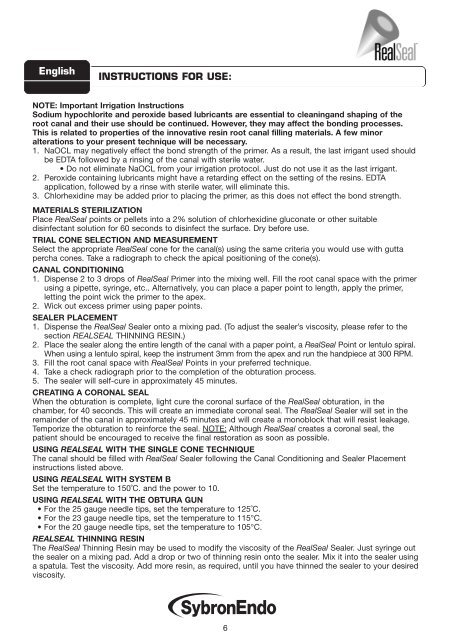INSTRUCTIONS FOR USE - SybronEndo
INSTRUCTIONS FOR USE - SybronEndo
INSTRUCTIONS FOR USE - SybronEndo
Create successful ePaper yourself
Turn your PDF publications into a flip-book with our unique Google optimized e-Paper software.
English<br />
<strong>INSTRUCTIONS</strong> <strong>FOR</strong> <strong>USE</strong>:<br />
NOTE: Important Irrigation Instructions<br />
Sodium hypochlorite and peroxide based lubricants are essential to cleaningand shaping of the<br />
root canal and their use should be continued. However, they may affect the bonding processes.<br />
This is related to properties of the innovative resin root canal filling materials. A few minor<br />
alterations to your present technique will be necessary.<br />
1. NaOCL may negatively effect the bond strength of the primer. As a result, the last irrigant used should<br />
be EDTA followed by a rinsing of the canal with sterile water.<br />
• Do not eliminate NaOCL from your irrigation protocol. Just do not use it as the last irrigant.<br />
2. Peroxide containing lubricants might have a retarding effect on the setting of the resins. EDTA<br />
application, followed by a rinse with sterile water, will eliminate this.<br />
3. Chlorhexidine may be added prior to placing the primer, as this does not effect the bond strength.<br />
MATERIALS STERILIZATION<br />
Place RealSeal points or pellets into a 2% solution of chlorhexidine gluconate or other suitable<br />
disinfectant solution for 60 seconds to disinfect the surface. Dry before use.<br />
TRIAL CONE SELECTION AND MEASUREMENT<br />
Select the appropriate RealSeal cone for the canal(s) using the same criteria you would use with gutta<br />
percha cones. Take a radiograph to check the apical positioning of the cone(s).<br />
CANAL CONDITIONING<br />
1. Dispense 2 to 3 drops of RealSeal Primer into the mixing well. Fill the root canal space with the primer<br />
using a pipette, syringe, etc.. Alternatively, you can place a paper point to length, apply the primer,<br />
letting the point wick the primer to the apex.<br />
2. Wick out excess primer using paper points.<br />
SEALER PLACEMENT<br />
1. Dispense the RealSeal Sealer onto a mixing pad. (To adjust the sealer’s viscosity, please refer to the<br />
section REALSEAL THINNING RESIN.)<br />
2. Place the sealer along the entire length of the canal with a paper point, a RealSeal Point or lentulo spiral.<br />
When using a lentulo spiral, keep the instrument 3mm from the apex and run the handpiece at 300 RPM.<br />
3. Fill the root canal space with RealSeal Points in your preferred technique.<br />
4. Take a check radiograph prior to the completion of the obturation process.<br />
5. The sealer will self-cure in approximately 45 minutes.<br />
CREATING A CORONAL SEAL<br />
When the obturation is complete, light cure the coronal surface of the RealSeal obturation, in the<br />
chamber, for 40 seconds. This will create an immediate coronal seal. The RealSeal Sealer will set in the<br />
remainder of the canal in approximately 45 minutes and will create a monoblock that will resist leakage.<br />
Temporize the obturation to reinforce the seal. NOTE: Although RealSeal creates a coronal seal, the<br />
patient should be encouraged to receive the final restoration as soon as possible.<br />
USING REALSEAL WITH THE SINGLE CONE TECHNIQUE<br />
The canal should be filled with RealSeal Sealer following the Canal Conditioning and Sealer Placement<br />
instructions listed above.<br />
USING REALSEAL WITH SYSTEM B<br />
Set the temperature to 150˚C. and the power to 10.<br />
USING REALSEAL WITH THE OBTURA GUN<br />
• For the 25 gauge needle tips, set the temperature to 125˚C.<br />
• For the 23 gauge needle tips, set the temperature to 115°C.<br />
• For the 20 gauge needle tips, set the temperature to 105°C.<br />
REALSEAL THINNING RESIN<br />
The RealSeal Thinning Resin may be used to modify the viscosity of the RealSeal Sealer. Just syringe out<br />
the sealer on a mixing pad. Add a drop or two of thinning resin onto the sealer. Mix it into the sealer using<br />
a spatula. Test the viscosity. Add more resin, as required, until you have thinned the sealer to your desired<br />
viscosity.<br />
6


